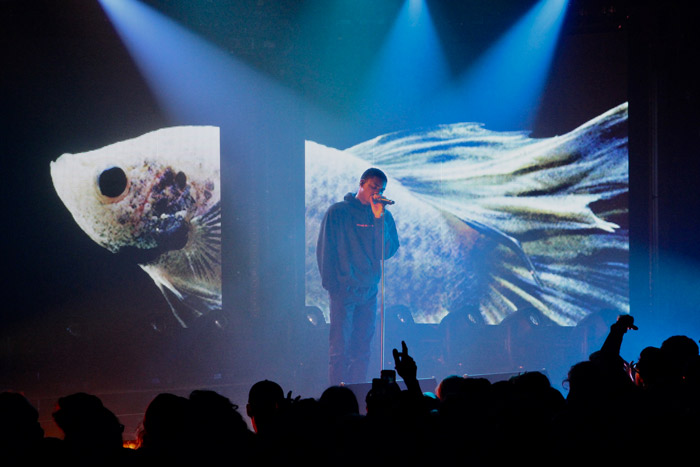It hasn’t taken long for Vince Staples to carve out his lane in the West Coast gangsta rap scene. After a slew of teenage mixtapes, as well as a few features on early Odd Future releases, Staples broke through to the mainstream hip-hop consciousness with his 2014 EP, Hell Can Wait. His approach was uncompromisingly hard-nosed; his ear for eerie, driving beats was staggering. When Summertime ‘06 dropped in 2015, Staples’ sprawling, 20 track opus left few doubters in the hip-hop community. 2016 saw the release of yet another universally lauded EP, Prima Donna, delivered alongside an experimental short film.
To say the least, it’s been a busy three years for the 23-year-old artist. His recent work has found him delving into more sonically experimental directions, but his brand has never strayed from his signature gritty, realist roots.
On Saturday, March 25, ahead of his forthcoming Big Fish Theory album release, Staples brought The Life Aquatic Tour before a crowd of understandably stoked Montrealers. With the lavish Corona Theatre filled to sweaty capacity, the rapper could do no wrong as he ran through selections from across his oeuvre. Crowd-surfing bodies soared across the swaths of wide-eyed fans; a churning sea of millennial hip hop heads bouncing side to side, feeding off Staples’ abundant charisma.
Staples’ presence commanded more than enough attention to fill out the space. He stood alone on an empty stage, foregoing audacious rap fashion in favour of a simple black hoodie. Although cool in demeanour, the performance was marked by a gripping sense of volatility. Slower songs, including Summertime ‘06 cuts “Lemme Know” and “Birds & Bees,” were delivered with Staples’ trademark hard-nosed stoicism, his gaze fixed on the back of the room. More familiar cuts, however, burst this tense, restrained atmosphere into furious catharsis. Staples demonstrated the ability to leap between registers from verse to verse, rendering his song structures and flow refreshingly unpredictable. Favourites such as “Prima Donna” and “Blue Suede” saw the rapper explode into three dimensions, bouncing across the stage as if in the midst of the mosh pit sprawled out before him.
In keeping with the Life Aquatic theme, Staples’ performance was backed by a tri-panel projection screen showcasing brilliant, atmospheric shots of underwater life, alongside the occasional bubbling skull, as well as a few scenes from the streets of his hometown, Long Beach, California. The supremely tranquil imagery of the sea creatures provided an eerie juxtaposition to Staples’ aggressive, street savvy bars. Huge, luminous goldfish trespassed slowly across the stage, but instead of David Attenborough’s affable narration of the proceedings, Staples held his mic aloft while legions of hungry fans yelled in chorus, “Bitch you thirsty please grab a Sprite.”
Perhaps even more prominent than this visual juxtaposition, the concert was repeatedly permeated by total blackness. Between uproarious bangers and more low key selections, the lone figure on stage was subsumed by darkness, disappearing into the chaos of the evening. Like the titular character of Wes Anderson’s The Life Aquatic With Steve Zissou, and like the marginalized individuals populating many of Staples’ songs, the concert teetered on this exhilarating, terrifying brink of nothingness throughout.
Although it can be somewhat jarring to witness a primarily white audience chant, “I ain’t never ran from nothin’ but the police” in unison with a black performer, Staples’ confidence and sheer charisma on stage skirted any trace of hesitancy, creating an entirely immersive spectacle. In the voluminous Corona Theatre, alternately bathed in the glow of sparkling sea creatures and total darkness, we were part of Staples’ universe—if only for a brief, thrilling moment.








